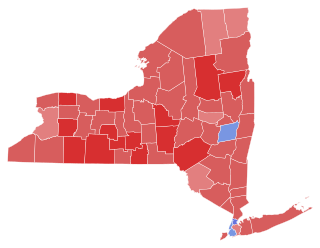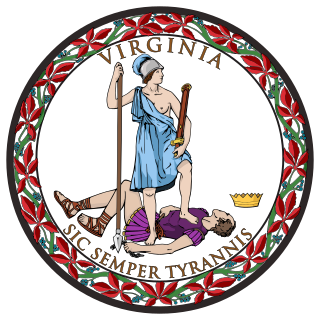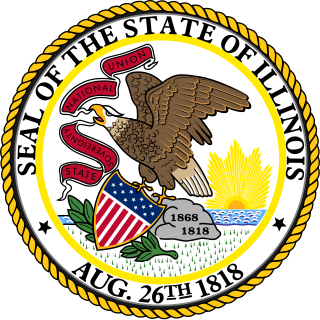
John Nichols Dalton was an American politician who served as the 63rd governor of Virginia, from 1978 to 1982. Dalton won the office with 55.9% of the vote, defeating Democrat Henry E. Howell Jr. and Independent Alan R. Ogden. Dalton had previously served as Lieutenant Governor of Virginia.

Thomas Bahnson Stanley was an American politician, furniture manufacturer and Holstein cattle breeder. A Democrat and member of the Byrd Organization, Stanley served in a number of different political offices in Virginia, including as the 47th speaker of the Virginia House of Delegates and as the Commonwealth's 57th governor. He became known for his support of the Massive Resistance strategy to prevent school desegregation mandated by the United States Supreme Court's decisions in Brown v. Board of Education, and Virginia's attempt to circumvent those decisions was known as the Stanley Plan.

James Lindsay Almond Jr. was an American lawyer, state and federal judge and Democratic party politician. His political offices included as a member of the U.S. House of Representatives from Virginia's 6th congressional district (1946–1948), 26th Attorney General of Virginia (1948–1957) and the 58th Governor of Virginia (1958–1962). As a member of the Byrd Organization, Almond initially supported massive resistance to the integration of public schools following the United States Supreme Court decisions in Brown v. Board of Education, but when Virginia and federal courts ruled segregation unconstitutional, Almond worked with the legislature to end massive resistance.

The 1908 Republican National Convention was held in Chicago Coliseum, Chicago, Illinois on June 16 to June 19, 1908. It convened to nominate successors to President Theodore Roosevelt and Vice President Charles W. Fairbanks.

The Byrd machine, or Byrd organization, was a political machine of the Democratic Party led by former Governor and U.S. Senator Harry F. Byrd (1887–1966) that dominated Virginia politics for much of the 20th century. From the 1890s until the late 1960s, the Byrd organization effectively controlled the politics of the state through a network of courthouse cliques of local constitutional officers in most of the state's counties.

Henry Evans Howell, Jr., nicknamed "Howlin' Henry" Howell, was an American lawyer and politician from the Commonwealth of Virginia. A progressive populist and a member of the Democratic Party, he served in both houses of the Virginia General Assembly, was elected the 31st Lieutenant Governor of Virginia as an Independent Democrat, and made several runs for governor.
The 1920 Democratic National Convention was held at the Civic Auditorium in San Francisco, California from June 28 to July 6, 1920. It resulted in the nomination of Governor James M. Cox of Ohio for president and Assistant Secretary of the Navy Franklin D. Roosevelt from New York for vice president. The 1920 Democratic National Convention marked the first time any party had held its nominating convention in a West Coast city.
Howard Hearnes Carwile was an American lawyer and politician.

The 1904 Democratic National Convention was an American presidential nominating convention that ran from July 6 through 10 in the Coliseum of the St. Louis Exposition and Music Hall in St. Louis, Missouri. Breaking with eight years of control by the Democratic Party's reform wing, the convention nominated conservative Judge Alton B. Parker of New York for president and Henry G. Davis of West Virginia for vice president.

Theodore Roosevelt Dalton was an American attorney and a United States district judge for the United States District Court for the Western District of Virginia. He was known as Virginia's "Mr. Republican."

The 1989 Virginia gubernatorial election was held on November 7, 1989. Incumbent Democratic Governor Jerry Baliles was unable to seek a second term due to term limits. Democratic nominee and Lieutenant Governor L. Douglas Wilder went against former Attorney General of Virginia J. Marshall Coleman in one of the closest elections in Virginia history. Upon taking the oath of office in January 1990, Governor Wilder became the first African-American governor of Virginia, and the first African-American governor of any state since Reconstruction more than one hundred years earlier.

The 1958 New York state election was held on November 4, 1958, to elect the governor, the lieutenant governor, the state comptroller, the attorney general, a judge of the New York Court of Appeals and a U.S. Senator, as well as all members of the New York State Assembly and the New York State Senate.

The 1938 Oregon gubernatorial election took place on November 8, 1938. In the election for governor of Oregon, Republican nominee Charles A. Sprague defeated Democratic nominee Henry L. Hess. Incumbent governor Charles Martin lost in the Democratic primary to Hess, an attorney and former state senator from La Grande. Hess was a strong supporter of President Franklin Delano Roosevelt's New Deal while Martin was a frequent critic of the program.
Allie Edward Stakes Stephens, usually known as "A. E. S." or "Gi" Stephens, was a Virginia lawyer and Democratic Party politician who served in both houses of the Virginia General Assembly and as the 27th lieutenant governor of Virginia from 1952 to 1962. His state political career ended with a loss in the Democratic primary for Governor in 1961, after he and Governor J. Lindsay Almond broke with the Byrd Organization, which wanted to continue its policy of massive resistance to desegregation of Virginia's schools after both the Virginia Supreme Court and a 3-judge federal panel ruled most elements unconstitutional in 1959.

In the 1961 Virginia gubernatorial election, incumbent Governor J. Lindsay Almond, a Democrat, was unable to seek re-election due to term limits. H. Clyde Pearson was nominated by the Republican Party to run against former Democratic Attorney General of Virginia Albertis Harrison.

In the 1953 Virginia gubernatorial election, incumbent Governor John S. Battle, a Democrat, was unable to seek re-election due to term limits. Virginia State Senator Theodore Roosevelt Dalton was nominated by the Republican Party to run against former Democratic U.S. Representative Thomas B. Stanley.
Kenneth Cartwright Patty was a Virginia lawyer who served as the 27th Attorney General of Virginia. Patty was an assistant attorney general before Governor Thomas Stanley appointed him after the resignation of his boss, J. Lindsay Almond.

Frederick Thomas Gray was a Virginia attorney and Democratic Party politician. Governor J. Lindsay Almond appointed Gray to serve as Attorney General of Virginia after the resignation of Attorney General Albertis Harrison to run for Governor of Virginia during the Massive Resistance crisis in Virginia. Gray returned to private practice at Williams Mullen after Robert Young Button took office. Gray later served in the Virginia House of Delegates and the Virginia Senate as he continued his law practice.

The 1912 Colorado gubernatorial election took place on November 8, 1912. Democratic state Senator Elias M. Ammons defeated the Progressive, Republican and Socialist candidates future Senator Edward P. Costigan, Clifford C. Parks and Charles A. Ashelstrom with 42.91% of the vote.

Elections were held in Illinois on Tuesday, November 3, 1936.



















